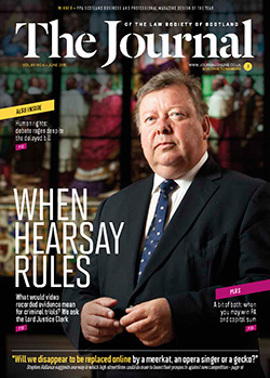CML Handbook: the new deal

The CML Working Party, formed following the “no” vote against the separate representation of borrowers and lenders in residential conveyancing transactions in September 2013, has completed its remit to engage with the CML in seeking amendments to the Scottish version of the CML Handbook, to provide clarity to conveyancers and make it more suitable for Scottish practice and procedure.
Introduced in 2000, the handbook provides comprehensive instructions for solicitors acting on behalf of lenders in residential conveyancing transactions. The rationale for its introduction was the standardisation of mortgage instructions. It is divided into three parts. Part 1 sets out the main instructions. Part 2 details each lender’s specific requirements. Part 3, introduced in July 2012, does not apply to Scotland: it sets out standard instructions for solicitors in England & Wales acting only for the lender.
The Scottish Handbook was reviewed to update a number of the existing instructions in part 1 to reflect recent changes in law and practice. Some of the amendments were introduced on 1 December 2014, and were publicised to the Society’s members last year via the e-bulletin and professional practice updates section of the website. The main changes as at 1 December 2014 included:
1. In clauses 1.6, 1.7, 5.1.1, 5.8.1, 5.11, 9.2 and 16.2.2, the word “proprietor” has been deleted and replaced with either “owner” or “seller” as necessary, because the use of “proprietor” for both seller and buyer was causing confusion.
2. In clause 3.1, the reference to “independent licensed conveyancers” has been deleted, as they no longer exist in Scotland.
3. Clause 3.2 was updated to ensure consistency across jurisdictions. The reference to “notepaper” has been deleted, and there is reference instead to the address “provided to you”. This was changed to deal with the issue where the correspondence is in the main electronic, and to encourage the solicitor to check against any/all of the addresses they are provided with, as lenders have encountered the use of both fictitious headed notepaper and fictitious addresses.
4. Clause 4.1.1 has been amended to clarify that solicitors are not expected to pick up any discrepancies between the valuation report they receive and what the lender has, if the lender does not supply the valuation report to the solicitor.
5. Clause 5.4 has been amended to update references in relation to building and planning regulations.
6. In clause 5.7, the references to “real burden” have been deleted and replaced by “title condition”.
7. In clause 5.9.1, an additional sentence has been added in relation to the solicitor’s duty to ask the borrower how the balance of the purchase price is being provided. For the avoidance of doubt, if the balance is being provided by way of a gift or loan to the borrower, this should be disclosed to the lender.
8. Clause 6.14 has been simplified to delete the list of insured risks and range of questions in relation to buildings insurance requirements.
9. Clause 11.2 has been amended to clarify the solicitor’s responsibilities in relation to explaining the mortgage documents to the borrower.
Now also changed
The more recent changes take effect from 8 June 2015. These include:
1. In clauses 10.4 and 15.1, the reference to stamp duty land tax has been deleted and replaced by the new land and buildings transaction tax with effect from 1 April 2015.
2. There are also changes to reflect the Land Registration etc (Scotland) Act 2012 which came into effect on 8 December 2014. Clauses 14.1 and 14.2 have been amended to reflect the fact that land and charge certificates are no longer produced. The working party also discussed advance notices in a dual representation situation where the same solicitor is acting for a borrower and a lender. It was agreed that while this should be a matter for the solicitor’s professional judgment depending on the circumstances of the individual case, an advance notice should be used where a classic letter of obligation would have been used. So in the normal case, there would be no need to request an advance notice in a dual representation scenario.
3. Clause 5.5.1 has been revised in Scotland to reflect changes made to the wording in the handbook for England & Wales. In particular, the absolute obligation on the solicitor to ensure that title to the property following completion is vested in the borrower has been diluted, as the obligation is now to “take reasonable steps to ensure” that title to the property is vested in the borrower.
As Alistair Morris, who was convener of the working party, said in the recent press release, the CML Handbook is a living document and will require further changes as time progresses and risk and practices change.
In this issue
- Weighing the risks
- Private parking fines – are they enforceable?
- Scotland – home of (dangerous) golf
- Shareholder details: the right to refuse
- Perils of the owner-occupied croft (fuller version)
- Reading for pleasure
- Opinion: Thomas Ross
- Book reviews
- Profile
- President's column
- Land Register completion: one year in
- People on the move
- Rights: whose final say?
- The word on the street
- Screen test
- Making the best of mediation
- Keep up the payments
- The right priorities
- When reputation is not enough…
- Sports justice – being seen to be done?
- Source of disputes
- CML Handbook: the new deal
- Perils of the owner-occupied croft
- In-house and in-tune in the Commonwealth
- Stair Society seeks new blood
- New Build Standard Clauses revised
- Law reform roundup
- Leven's last hole rarely in benevolent mood
- Year of the new look
- AML just became simpler
- "My time is valuable!" Oh really?
- Learning opportunity
- Ask Ash
- Technology: slave or master?






